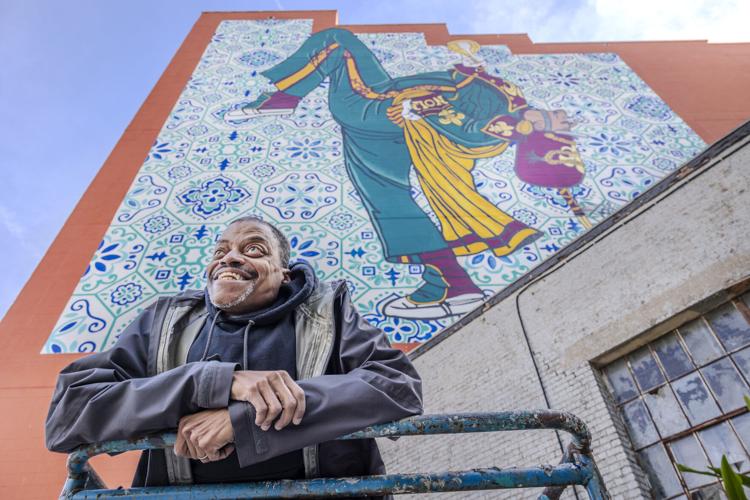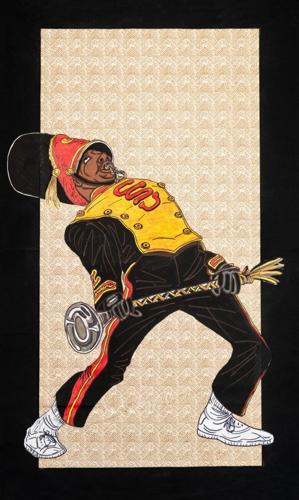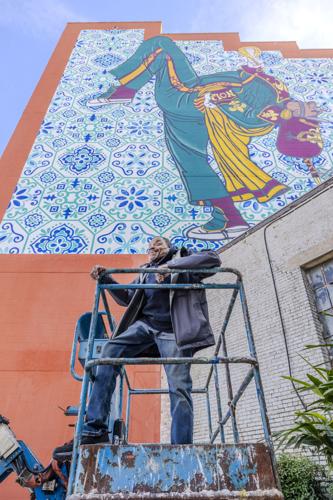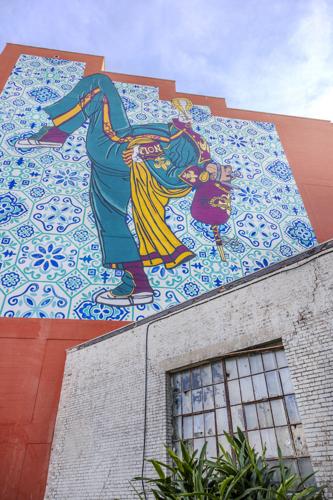Drum majors tend to be tall, and they tend to be flexible. Artist Keith Duncan’s drum major, painted on the Ogden Museum of Southern Art, certainly fits the bill.
He’s tall all right, almost 90 feet, and he’s pointing a knee toward the clouds while bending his spine so far back that the tip of his upturned baton almost brushes the ground.
Because of its punchy, off-kilter composition, Duncan’s "Drum Major of NOLA" is the most striking of the big downtown murals to date. The big dude’s knee breaking out of the background is really a nice touch.
The placement of the mural may not be perfect. It’s surrounded by parking lots and invisible from the front of the Ogden at 925 Camp St. But it can easily be seen from busy St. Charles Avenue. Duncan said he likes that streetcar riders can catch a glimpse of the contorted giant as they rumble past St. Joseph Street.
Duncan said his gigantic drum major doesn’t represent any particular band. He’s an amalgam of all of the flamboyant high steppers who add their special panache to the Mardi Gras season as they march along St. Charles Avenue, the city’s No. 1 parade route. Hence the purple, green and gold uniform marked with fleurs-de-lis.
Viewing the mural from the route during a passing parade is sure to have a wonderful resonance.

A giant mural of a musician on the wall behind the Ogden Museum of Southern Art in New Orleans by artist Keith Duncan on Thursday, December 7, 2023. (Photo by Chris Granger, The Times-Picayune)
Hometown radical
Duncan is a native of New Orleans, born in Charity Hospital 59 years ago, though he grew up downriver near Buras. He attended Delgado Community College and LSU, and earned a master’s degree at Hunter College in New York City, remaining in Harlem and the Bronx for 15 years afterward.
In 2008, Duncan returned to the 504, where he earned a radical reputation on the local art scene for his controversial paintings that included racist stereotypes. As a Black man, Duncan’s work was obviously meant to illuminate social ills and prejudice, but it still made everybody squirm a little.
His brazenness earned him a place in some big shows, including "Prospect. 2", New Orleans’ international art exhibition in 2012.
In the years since, he said, his theme has shifted. Duncan said he created a series of Black history paintings that depicted his subjects as “victors instead of victims.” That series led to his recent interest in historically Black colleges and universities, which are a big part of American history. Duncan began painting the renowned Southern and Grambling State University bands, then expanded to others. At the Manhattan gallery that sells his work, Duncan said art lovers snapped up all of his “Southern Classic” series.
Duncan said he intends his giant drum major mural as a touchstone with HBCU traditions. At first, Duncan said, he considered depicting a whole marching band on the museum wall, but the mural selection committee liked the single, dramatic drum major better, so he went with that.

Artist Keith Duncan and his musician mural on the wall behind the Ogden Museum of Southern Art in New Orleans on Thursday, December 7, 2023. (Photo by Chris Granger, The Times-Picayune)
From ironic to comforting
Onlookers will probably wonder why Duncan’s acrobatic band leader is painted on a rather dowdy blue and white patterned background that doesn’t seem to relate to marching bands, or Mardi Gras, or anything else for that matter. Duncan explained that, instead of plain white canvas, he prefers to paint on store-bought, patterned fabric, to lend his paintings a downhome feel.
“I want to have the fabric deal with my Southern roots,” he said.
A decade ago, when Duncan’s themes were much edgier, the fabric underscored the irony of the images he painted. As a critic wrote in 2012, “Imagine a gritty gangster send-off (funeral) taking place on a background that is poignantly reminiscent of grandma’s curtains.”
The fabric-inspired background is no longer poignant; now the pattern adds a sort of comforting incongruence. The use of the decorative background may be odd, but it’s much more interesting than if Duncan had opted for something more naturalistic. Artworks that don’t make perfect sense are always better than artworks that do.

A giant mural of a musician on the wall behind the Ogden Museum of Southern Art in New Orleans by artist Keith Duncan on Thursday, December 7, 2023. (Photo by Chris Granger, The Times-Picayune)
Going big
Duncan didn’t paint the skyscraping mural himself. He rode up on the small mechanical platform a time or two to do some brushwork, but, he said, “I don’t care too much for heights.” Happily, professional mural painters Wendo Brunoir and Jolean Barkley were amenable to high-altitude art making.
The project was a challenge, Brunoir said, because of the scale and the position of the wall, which intersects another one-story structure, sometimes making it tough to get the motorized manlift in place. And the fabric pattern, which Brunoir said reminds him of hand-painted tiles, was a touch tedious. But he and Barkley managed. Overall, the project took about a month.
Duncan said he intends his mural to be “my gift to the city.” He’s said he’s happy that the subject seems on point, but not too on point. He’d considered a grid of fleurs-de-lis in the background, but that seemed a bit touristy. And the drum major’s toned-down uniform colors symbolize Mardi Gras, “without screaming Mardi Gras,” he said.
Duncan’s mural titled "Drum Major of NOLA" is the 10th gigantic painting in the Central Business District produced by The Helis Foundation’s UNFRAMED project, which is managed by Arts New Orleans.








